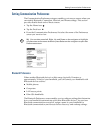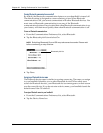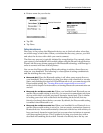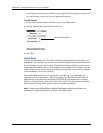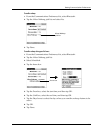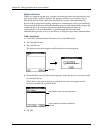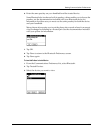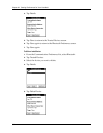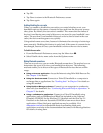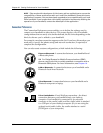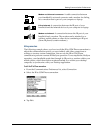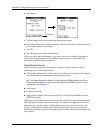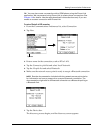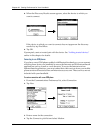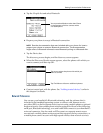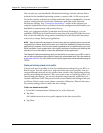
Setting Communication Preferences
397
6. Tap OK.
7. Tap Done to return to the Bluetooth Preferences screen.
8. Tap Done again.
Enabling/disabling the user cache
When you enable or disable the user cache you control whether or not your
handheld retrieves the names of remote devices each time the discovery process
takes place. By default, the user cache is enabled. This means that the names of
devices found during one round of discovery are stored in your handheld’s user
cache. The next time your handheld discovers a device that is listed in the user
cache, the device name appears very quickly.
Using cached names saves time, because it eliminates the extra step of retrieving a
name remotely. Disabling this feature is useful only if the name of a remote device
has changed, because it forces your handheld to retrieve the new device name.
To disable the user cache:
1. From the Bluetooth Preferences screen, tap the Menu icon .
2. Select Disable device name cache from the Options menu.
Making Bluetooth connections
There are several ways you can make Bluetooth connections. The method you use
determines the types of devices your handheld can discover. The following
methods enable you to discover the types of Bluetooth devices that are within
range:
■ Using an Internet application: Access the Internet using Palm Web Browser Pro.
See Chapter 19 for details.
■ Using the Send command: Connect to a Palm OS handheld or a computer to
exchange data or applications. See “Sending data” in Chapter 3 for details on
using this method.
■ Using HotSync Manager software: Connect to your computer to synchronize
data with your handheld. See “Conducting Bluetooth HotSync operations” in
Chapter 21 for details.
■ Using a collaborative application: Connect to a Palm OS handheld using
applications such as BlueBoard and BlueChat included on the Software
Essentials CD-ROM. See the BlueBoard 2.0 Handbook and the BlueChat 2.0
Handbook on the Software Essentials CD-ROM to learn more about these
applications. Other third-party applications may be available. Visit
www.palm.com/intl
for information about downloading third-party
applications, and refer to the documentation that comes with these applications
for details on using them.



